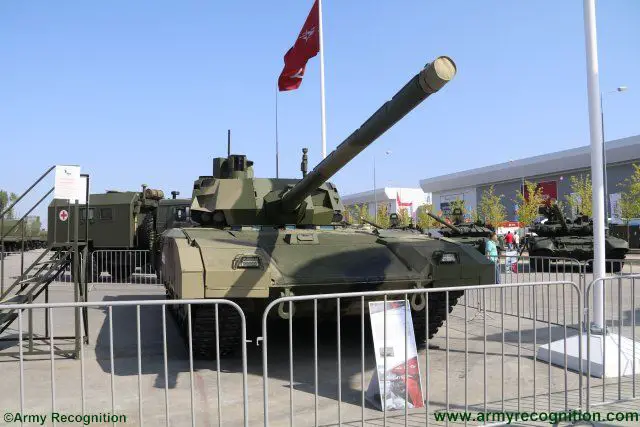Breaking news
Army-2017: Armata family of vehicles to be fitted with new mobile power stations 22308172.
| 2017
 |
|||
|
Army Recognition
Online Show Daily News & Web TV Army 2017 International military and technical forum 22 - 27 August 2017 Moscow, Russia |
|||
|
Russian Armed Forces at Army 2017
|
|||
|
|
|||
|
|
|||
Army-2017: Armata family of vehicles to be fitted with new mobile power stations |
|||
|
Russia’s Armata-family combat vehicles will receive mobile power stations. These devices will be installed between the tank's storage batteries and engine. They will ensure an instant and smooth start of the engines at 50 degrees below zero, as well as the operation of turret traversing mechanisms, armament stabilization and combat control systems. This opportunity will be provided by supercapacitors - devices capable of instantly accumulating a large amount of electricity even from an empty battery and supplying the on-board systems for some time until the main engine is started, the newspaper Izvestia writes.
|
|||
|
|
|||
 The T-14 Armata main battle tank presented at Army-2017 exhibition |
|||
|
|
|||
|
The scheme of the device is similar to the starters of the "start-stop" system, a technology designed to automatically turn off and restart the engine of the car to save fuel. The supercapacitor is able to compensate for energy loss when the engine is switched on and off repeatedly and increases the battery life. For the latter, this figure is several thousand charge-discharge cycles. The supercapacitor provides a million times more cycles.
Supercapacitors have been designed and manufactured by the Renova Group. Currently, these devices are supplied for city electric buses and starting loco diesels. As Mikhail Lifshits, director for high-tech assets development at Renova, told Izvestia, the products are currently offered to the military. The supercapacitor is studied as standard equipment for modernized Russian tanks, as well as Armata-family armored vehicles. "We carried out full-scale tests of a supercapacitor for the cold start of a tank diesel engine," said Mikhail Lifshits. "The vehicle stood in the frost for a few days and its batteries were completely empty. Nevertheless, with the help of a supercapacitor-based mobile power station (its size did not exceed a conventional attache case), we were able to start a cold engine several times in a row. The use of such a device allows you to free the battery compartment of the tank almost by half for any other payload." |
|||
|
|
|||
 These devices will be installed between the tank's storage batteries and engine |
|||
|
|
|||
|
Expert Sergey Suvorov told Izvestia that the problem of the internal volume of armored vehicles is among most urgent for designers. Each liter of the interior space means an additional 100 kg of the structural weight. Freeing the internal volume not only reduces the weight of the tank, but also helps you to increase the amount of fuel and ammunition in the vehicle.
"Currently, the tank designers are fighting for fire safety," said Suvorov. "This leads to abandoning hydraulic armament stabilization and turret traverse systems. They are unreliable and, in case of the slightest damage, lead to the destruction of the turret. In addition, the turrets became very heavy. To rapidly traverse them 90-180 degrees, additional power plants, 10-kW diesel generators, are mounted. In the US tanks, this system is located in the outer box behind the turret. In Iraq, there were many situations when it was destroyed by machine gun fire. Oil leaked out and went right into the engine compartment. As a result, the tank became immobilized. The Americans classify these losses as those due to "secondary features." But the fact remains that... the tank was knocked out by a machine gun." Using a supercapacitor makes it possible to replace hydraulics with a magnetic turret traverse system. Moreover, this not only provides a quick turn of the gun in the proper direction, but also activates the tank combat control system before the main engine is started, that is, gives the opprtunity to immediately use weapons. Currently, the Armata-family tanks and the T-15 heavy IFVs, their derivatives, are considered the most advanced combat vehicles. According to Western experts, they have more advanced indicators of survivability than their closest counterparts in Western Europe and the United States, the Izvestia newspaper recalls. |
|||
|
|
|||
| © Copyright 2017 TASS. All rights reserved. This material may not be published, broadcast, rewritten or redistributed. | |||



















